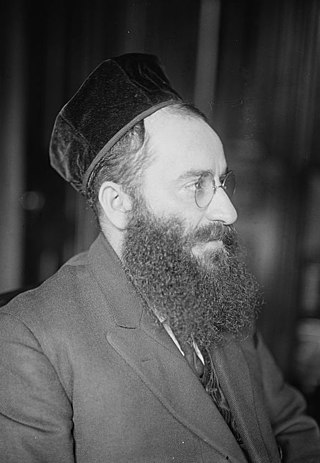Schenkerian analysis is a method of analyzing tonal music based on the theories of Heinrich Schenker (1868–1935). The goal is to demonstrate the organic coherence of the work by showing how the "foreground" relates to an abstracted deep structure, the Ursatz. This primal structure is roughly the same for any tonal work, but a Schenkerian analysis shows how, in each individual case, that structure develops into a unique work at the foreground. A key theoretical concept is "tonal space". The intervals between the notes of the tonic triad in the background form a tonal space that is filled with passing and neighbour tones, producing new triads and new tonal spaces that are open for further elaborations until the "surface" of the work is reached.

Igor Gorin was a Ukrainian Jewish baritone and music teacher. In screen credits, he is sometimes known as Charles Igor Gorin.
Pizmonim are traditional Jewish songs and melodies sung with the intention of praising God as well as learning certain aspects of traditional religious teachings. They are sung throughout religious rituals and festivities such as prayers, circumcisions, bar mitzvahs, weddings and other ceremonies.

Josef "Yossele" Rosenblatt was an Ashkenazi chazzan and composer. He was regarded as the greatest cantor of his time.
Abraham Wolf Binder was an American composer.
Jewish music is the music and melodies of the Jewish people. There exist both traditions of religious music, as sung at the synagogue and in domestic prayers, and of secular music, such as klezmer. While some elements of Jewish music may originate in biblical times, differences of rhythm and sound can be found among later Jewish communities that have been musically influenced by location. In the nineteenth century, religious reform led to composition of ecclesiastic music in the styles of classical music. At the same period, academics began to treat the topic in the light of ethnomusicology. Edwin Seroussi has written, "What is known as 'Jewish music' today is thus the result of complex historical processes". A number of modern Jewish composers have been aware of and influenced by the different traditions of Jewish music.
For the purposes of this article, “contemporary” refers to the period from 1967 to the present day, “Jewish” refers to the various streams and traits of Judaism practiced. Many Orthodox Jews use the term “religious” to refer to a strict adherence to Jewish law. For the purposes of this article, “religious” refers to the content and context of the music itself: liturgical or implicit references to the divine.
This article describes the principal types of religious Jewish music from the days of the Temple to modern times.
Nusach Ashkenaz is a style of Jewish liturgy conducted by Ashkenazi Jews. It is primarily a way to order and include prayers, and differs from Nusach Sefard and Baladi-rite prayer, and still more from the Sephardic rite proper, in the placement and presence of certain prayers.
The modern Reform Cantorate is seen as a result of developments that took place during the 19th century, largely in Europe. The process continued to evolve in America following the emigration of German Reform Jews towards the end of the century.

Herman Wohl was a Jewish–American composer closely associated with the American Yiddish Theatre.
Adele Terese Katz was a music teacher and music theorist, and writer. She was the first person to publish English-language writings about Schenkerian analysis.
Oswald Jonas was a music theorist and musicologist, and student of Heinrich Schenker. Despite Schenker's conservative nationalist views Jonas was an admirer of Karl Kraus.

Julius Mombach was a 19th-century English synagogue composer. Tunkel (2012) regards him as "the most important of the composers of synagogue music in the Anglo-Jewish tradition of the 19th Century" whilst Elton (2003) doesn't even restrict this assessment to England.
Neil W. Levin is a Professor Emeritus of the Jewish Theological Seminary, and since 1993 has served as the Artistic Director of the Milken Archive of Jewish Music.
Ernst Oster was a German pianist, musicologist, and music theorist. A specialist in the use of Schenkerian Analysis, he was the English translator of Heinrich Schenker's final work, Free Composition.
Ben Zion Shenker (1925–2016) was a world-renowned American Hasidic composer and hazzan (cantor), associated with the Modzitz hasidic dynasty. Shenker was born in the heyday of the American hazzan. He became interested in the art as a child, and was performing on radio by his early teens. Soon after, he became close to Rabbi Shaul Taub, the Holocaust-surviving Modzitz Grand Rabbi, who was known for his mystical Hasidic compositions. He dedicated much of his life to recording and publishing the large stock of pre-war Modzitz songs, as well as Taub's post-war work. Shenker created a music label, Neginah, for the purpose of recording those songs, and himself became a composer of hundreds Modzitz moded songs.
In Judaism, musical nusach refers the musical style or tradition of a community, particularly the chant used for recitative prayers such as the Amidah.

Timothy L. Jackson is an American professor of music theory who has spent most of his career at the University of North Texas and specializes in music of the eighteenth through twentieth centuries, Schenkerian theory, politics and music. He is the co-founder of the Journal of Schenkerian Studies. In 2020, he became controversial for editing a special issue of that journal containing articles criticizing Philip Ewell's plenary talk "Music Theory's White Racial Frame".
Jack A. Kessler (1944–2024) was an American hazzan, musician, and educator. After working as a cantor for synagogues for 20 years, he organized several musical ensembles including Atzilut, a group of Jewish and Arab musicians, which toured venues around the world including the United Nations. He also adopted the practice of chanting trop for haftarah and other biblical texts in both Hebrew and English to make the text more vivid and alive for synagogue worshippers.







